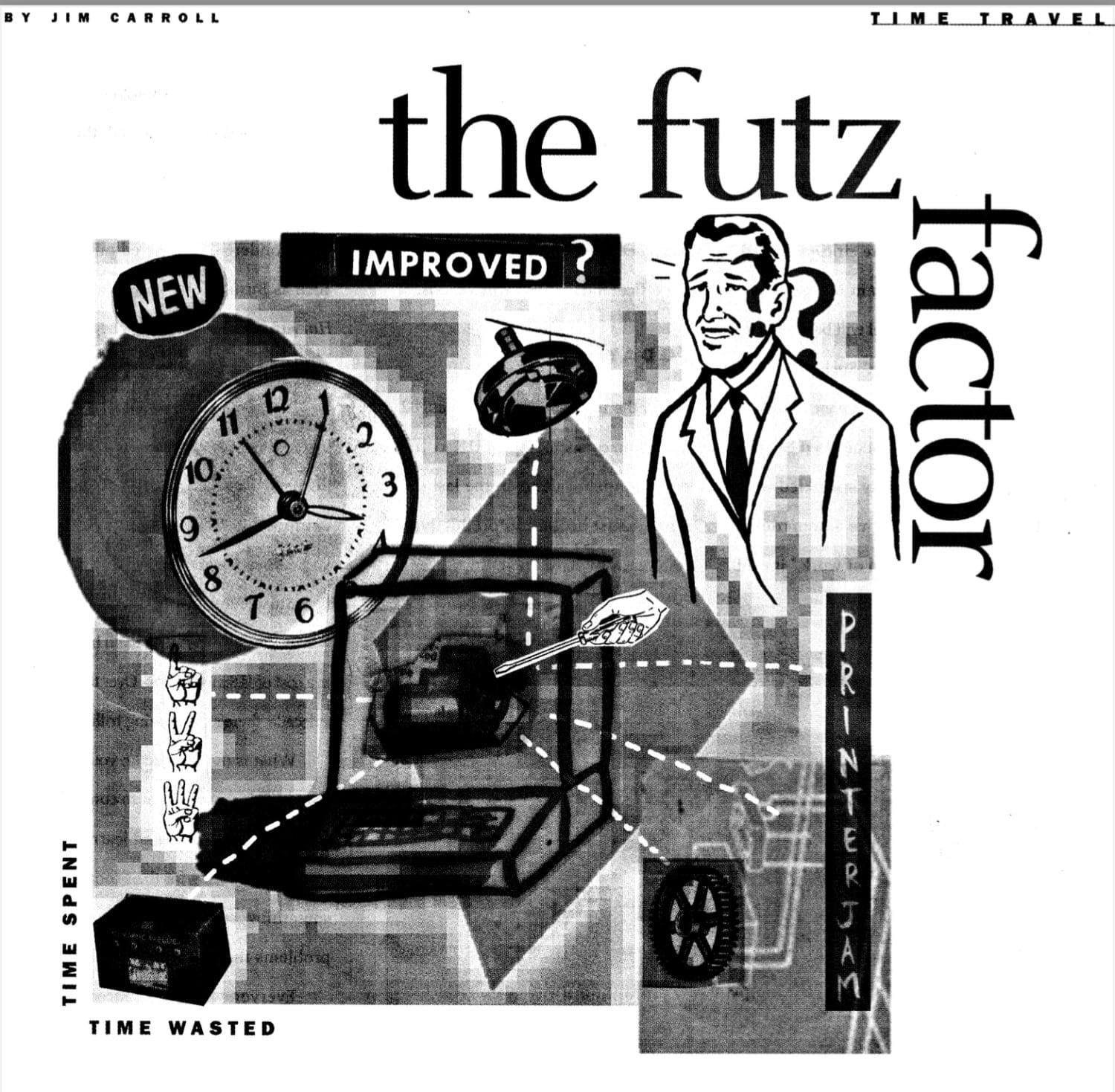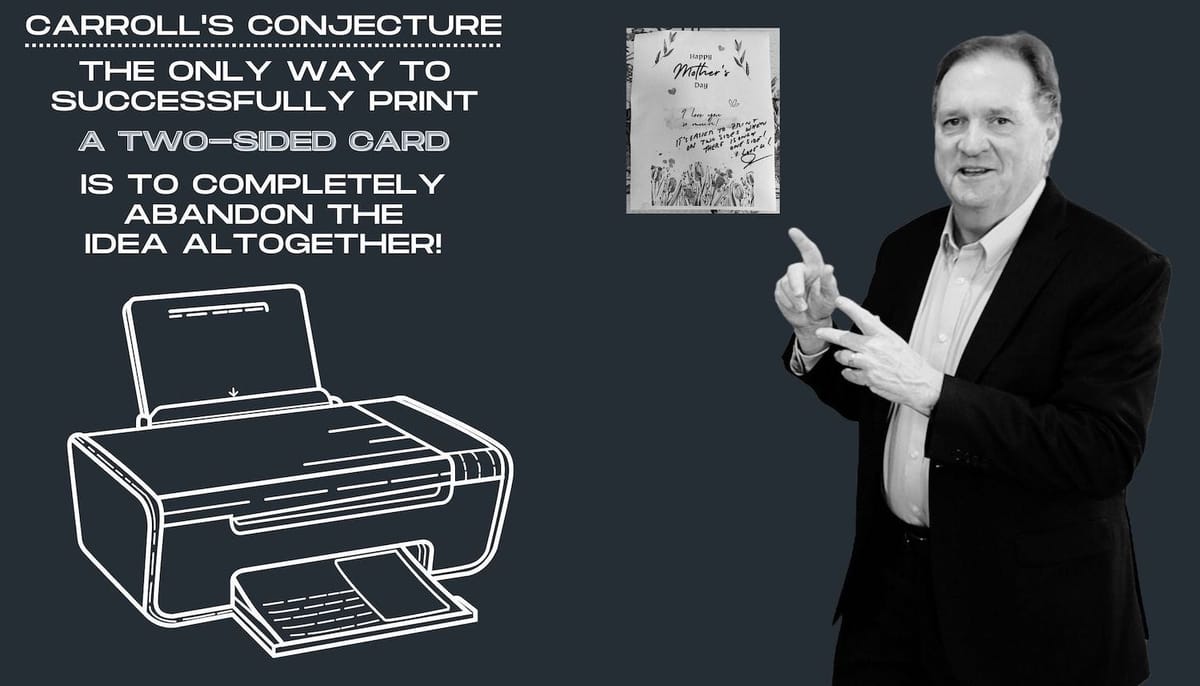I have never met anyone who has successfully, without significant mental trauma, printed a greeting card that folds properly, or, as the software and hardware companies suggest with their phrasing, print a 'two-sided card.'
I was reminded of this fact that one day last week when a neighbor of mine sent a message asking for help; she had prepared a wonderful photo collage for her daughter and needed some help figuring it out. I quickly advised her that this was not my department; that I had a rather difficult and perhaps hateful relationship with printers! I sent my wife over instead. And I was reminded of this Saturday when I created a Mother's Day card for my wife - we long ago agreed that we wouldn't spend money on traditional cards. With that in mind, I didn't bother to attempt to create a foldable card. I simply printed a single-sided piece of paper as seen above - problem solved!
My family has known for quite some time not to get me involved in the printing department. Indeed, we have two of them here, both a color laserjet and a traditional laser printer. Working in a home office for 33 years, we've gone through several printers, and in my mind, all have been attempts by the devil himself to place himself in our household. I resolved to not try to print things a few years ago, but every once in a while, creep back and give it a go. It never ends up well - paper jams, toner problems, network connectivity issues - or, in the case of the two-sided card,' abject failure.
Yet, it wasn't always this way. For a time, my wife was the one who was printer-challenged. I told this story in my book Surviving the Information Age, released in the '90s, which tells the tale of the difficult relationship that baby-boomers have with technology:
“The futz factor doesn’t involve just software; it can take over your relationship with a particular piece of hardware. In my case, I’ve had an ongoing battle with printers for several years. For a while, it got to the point that my wife would run from the room when I used the printer. She knew that as soon as I tried to print something, it wouldn’t work and that I would get frustrated to the point that I would either yell at the machine, curse my computer or give up and ask her to do it. The latter would always solve the problem.
“For some strange reason, I just couldn’t get the printer to co-operate with me. I don’t know exactly what it was, other than the futz factor. Any software program that I used — no matter what I did — caused a printing problem.
Then mysteriously, one day, my problems with printers went away, after one day, when I decided to hook the printer up to my wife’s computer instead. I could now access the printer through the network that we have. And so today, I can finally live with my printer in peaceful coexistence; I guess it has decided to accept me as I am.
My wife, however, can’t seem to get along with it anymore. I now run from the office every time she uses it, since I know that she will yell at the machine, curse her computer or give up and ask me to do it. I dread the day we have to buy a new printer, since I fear that we will never be able to print again.”
Excerpt From
Surviving The Information Age
by Jim Carroll
And that brings me to the futz factor - we spend far too much time in our lives futzing with the technology that has invaded it. I wrote about the futz factor - and my hate for printer technology, in my column in the Canadian Airlines Inflight Magazine; I wrote there for about 3 years from 1997 to 2000. The column took on the structure of examining various trends from the view of the past, today, and tomorrow.
And when it comes to printers, 20 years on, the futz factor has not changed much. I'm sure you can read it and agree with its premise!

Has this happened to you lately?
You try to print something, and it doesn’t print. Once you figure out what you think the problem is, you finally do manage to get it to print, except it doesn’t print exactly what you wanted. You try again, and manage to print it, but realize to your frustration that something has gone wrong: there are funny characters all over the page! You investigate further…..
You’ve just spent a half-hour fooling around, trying to get a two-page document to print. And in doing so, you are contributing to what the computer industry thinks is a very serious problem – the “productivity paradox.”
The Past
Almost as soon as office technology was invented, the adjectives of promise and potential populated news reports.

“If electronic devices are efficiently used,” noted the Financial Post in August 1954, “the saving in personnel will be matched by increased efficiency…”Such prose was typical; two years later, in a hopeful article with the title “Office Automation Need Not Cost Millions,” the same publication liberally sprinkled the phrases of the office automation revolution. “Reduction of work.” “Improvement in efficiency.” “Relief of tedium.” “Elimination of error.” “Descending office costs.” “New effectiveness.”
Thus was born the mantra of the computer era, as business publications began to speak of the bottom-line productivity improvement that was just around the corner. Computers would change the very nature of the office, and ease us from our frustrations.
Today
But by the 1990s, the tune had changed. “American companies spent $1 trillion on computer systems in the last decade with almost no gain in productivity,” noted Newsweek in 1995.
Reports began to circulate that even though huge sums of money were invested in information technology in the eighties and previous decades, there was a productivity improvement of but 0.7 percent Where was the missing efficiency, they wondered? Respected publications such as Business Week, Forbes and the Harvard Business Review undertook lengthy essays and analyses to understand what was going wrong, seeking complicated answers for a simple problem.
They could have saved a lot of time if they had discovered a report from Software Business Technology (SBT) of Sausalito, California, which found that staff spent 5.1 hours each week ‘futzing’ with computers. Add it up, and North American business was futzing away about 5 billion hours a year at a cost of $100 billion. Over the course of a decade, there are the missing trillion dollars.
What is the futz factor, you say? It is simple – it is the tendency where people end up wasting a lot of time learning about computers, waiting for their computer to do something. It is time spent solving the little, mundane problems that occur day-to-day as they struggle to master their machines -- such as not being able to get a document to print.
Everyone has experienced the futz factor. It is most common when you have had to master and install new software. Typical is the situation in which you have just spent a lot of time learning a particular computer program. You finally get things working just fine, but then rush out to get the new, “upgraded” version, tempted by the bells and whistles in the flashy sales ads. Once you figure out how to install the new version (which sometimes takes the better part of a day), you discover to your horror that the new program can’t read your old files. You end up frittering away even more time trying to solve that problem, only to discover days later that the manual that came with the upgrade forgot to tell you about an important step you were supposed to do during installation!
The futz factor has led to a unique variation on Murphy’s Law specifically for computers: Everything takes longer than you think.
Part of the reason for the futz factor is that in the never-ending quest for profit, the computer industry constantly releases “new and improved” software and hardware. The promise is made that all this new technology will offer us tremendous advantages and productivity gains. The fact of the matter is that new software will probably result in a situation in which an important document somehow disappears at a critical last minute.
When it comes to technology and the futz factor, it is clear that “Westheimer’s Rule” applies. This theorem states that to estimate the time it takes to do a task with a computer, you first estimate the time you think it should take. Then, multiply by two and change the unit of measure to the next highest unit.Thus, if you think something will take an hour to do on a computer, it will really take two days!
Tomorrow
The computer industry isn’t ready to give up. Open any marketing brochure, and the same tired words, “efficiency” and “productivity” are everywhere to be found.
Yet the fact of the matter is their never-ending quest for sales, each new software release contains hundreds or thousands of features that we will never use – leading some to call such upgrades “bloatware” or “fatware.” Consider one popular new “office productivity suite” – it would fill some 150 diskettes! No wonder they ship these things on CD-ROM! Install such an upgrade, and you are bound to futz away plenty more time, simply trying to get the darn thing to work.
Is there a way out? Perhaps. Out on the Internet, a new trend is emerging, one that we might call the “minimalist rule” of software design. In a sort of online competition, computer experts are attempting to design the smallest possible computer programs that can do one, simple, basic task. It’s sort of like that famous game show: “I can program that code in 37 bytes, Alex.”
Smaller is better, goes the thinking.
If the trend catches momentum, then maybe the futz factor, and hence the productivity paradox, will yet be solved.
And right there, you can find the key phrase about our lives today:
What is the futz factor, you say? It is simple – it is the tendency where people end up wasting a lot of time learning about computers, waiting for their computer to do something. It is time spent solving the little, mundane problems that occur day-to-day as they struggle to master their machines -- such as not being able to get a document to print.
And so today, this is what you need to know - avid the futz factor, particularly with two-sided cards, simply by printing on one side.
Problem solved!
Futurist Jim Carroll sometimes wishes he could display more maturity in his relationship with printer technology. Then he tries to print something and the thought goes away.
Thank you for reading Jim Carroll's Daily Inspiration. This post is public so feel free to share it.

